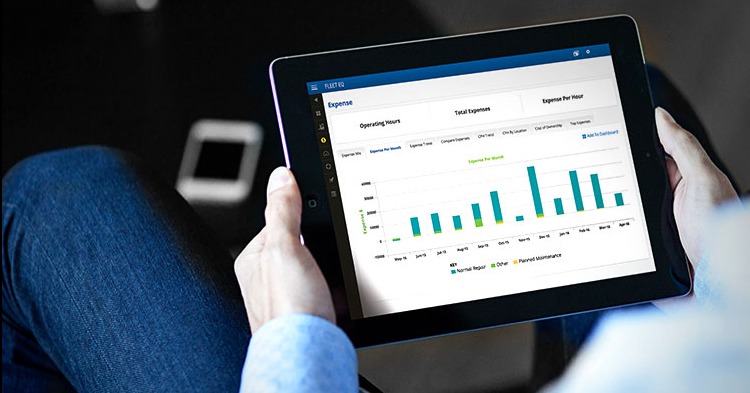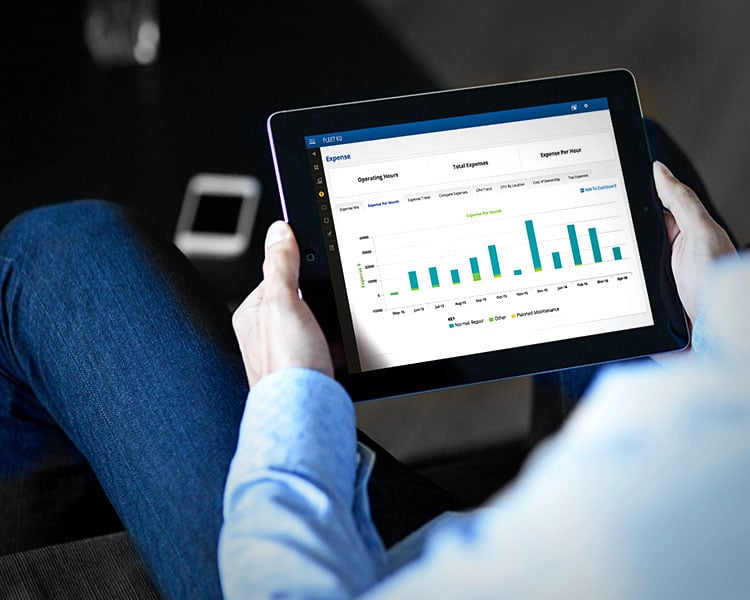
When it comes to optimizing your material handling equipment fleet, visibility and planning are key. You would not operate a lift truck with obstructions blocking your view. So why do many operations managers approach fleet management and cost-projections without reviewing critical information?
In the material handling industry, uptime is essential. However, much time is spent on fixing equipment and being reactive rather than developing proactive strategies that make your operation more efficient, productive, and profitable. Here are five fleet management best practices to keep in mind to achieve that goal:
1. Collect and Analyze Data
You likely know how many forklifts and other types of material handling equipment are in your fleet, but if you do not know the costs associated with each, you do not have all the data needed to operate your fleet in the most efficient manner. Determining the expenses for each piece of equipment will give you a complete view of total costs, as well as areas where savings can be realized.
Equipment performance data can provide information such as which tires are performing best, which equipment is operating most efficiently, and how long equipment is out of commission based on how long it takes your shop technicians to complete maintenance and repairs. Here are some metrics to monitor for each piece of equipment:
- Utilization
- Fuel consumption
- Tire wear
- Repair history
- License information
- Insurance cost
- Vehicle replacement cost
- Warranties
- Parts inventory
- Billing for customer use, if applicable
- Driver data
- Associated labor costs
- Cost per mile
Tracking and analyzing this data will give you a clearer picture of the total cost of ownership for each piece of equipment as well as help you identify costs you might not currently monitor. For example, you may own a piece of equipment that is only used to meet seasonal demand. After comparing cost data for yearly-maintenance, insurance and repairs, you may realize renting is a less-costly approach. What you don’t know can hurt you and your bottom-line. Having visibility into this data, enables you to make more strategic decisions about your equipment fleet and implement changes that improve efficiency and achieve cost savings.
2. Create a Fleet Management Plan
Buying material handling equipment as needed and running it into the ground is a haphazard approach. A proper fleet management plan will optimize your use of the equipment and the personnel who operate it, while also maximizing any potential return through resale.
- Invest in the right mix of equipment. Forklifts, pallet jacks and order pickers, for instance, all offer different capabilities. Evaluate how and where equipment will be used. Also, be very aware that overestimating your needs will result in unnecessary expenditures. Consider your leasing options for types of equipment that will not be needed on a regular basis.
- Establish appropriate vehicle-replacement cycles. Waiting until equipment breaks down to replace it could result in unexpected downtime as well as increased maintenance costs. Know the typical lifespan of each vehicle in your fleet and you may be able to capitalize on higher resale value before major repairs are needed.
- Develop, implement and enforce equipment usage and safety policies. To ensure compliance, provide the required training that meets your standards. Misusing equipment can shorten its life and result in workplace injuries.
3. Adopt a Regular Maintenance Schedule
Depending on your industry, your material handling equipment may be your hardest-working fleet. If you schedule regular maintenance for cars and trucks, why wouldn’t you do the same with your material handling equipment? Avoiding downtime keeps your company up and running and your customers satisfied. Breakdowns from neglect will only result in extended downtime, and the repairs typically are far more expensive than the cost of regular maintenance. Neglect of equipment not only effects your bottom-line but your people too. Keeping your equipment well maintained ensures your employees are operating safe equipment.
Unlike reactive maintenance — fixing something after signs of trouble appear — proactive maintenance can prevent problems that otherwise would grow in scale. It can also result in improved fleetwide fuel efficiency. Proactive maintenance includes oil changes as well as checking (at a minimum) the following systems:
- Brake system
- Fuel system
- Hydraulic system
- Coolant system
- Exhaust system
A well-maintained fleet also benefits your operators. Brake or engine failure or a flaw in the steering system can lead to serious injuries and even death. Another advantage of preventive maintenance is that you determine and control the downtime for specific pieces of equipment and can create a schedule that works best for your business.
4. Use Fleet Management Technology for Real-Time Visibility
Regularly reviewing data provided by fleet management software is proven to positively impact fleet operations and a business’s bottom line. With a tight labor market threatening productivity, putting technology to use can make a real difference in your profitability. Software capabilities can help you do the following:
- Retrieve on-demand data about equipment location, usage and performance
- Review inspection, service history and maintenance reports
- Analyze data from multiple locations or distribution centers
- Control costs by tracking spending vs. goals and budgets
- Access an interactive dashboard from your computer, phone or tablet
- Provide online reporting access for team members throughout your organization
- Customize detailed reports
- Determine the best equipment mix
- Calculate the total cost of ownership for all fleet equipment
- Streamline operations
- Maximize uptime
5. Choose the Right Partner — One Source That Can Meet All Your Fleet Management Needs
There are many aspects to managing a fleet of forklifts and other material handling equipment. Using different suppliers for buying new and used equipment, rentals, maintenance, repairs, parts, software, warehouse systems and other needs is inefficient by definition. You have to contact each one, outline your needs in detail and pay multiple entities — just for starters. To optimally implement fleet management best practices, vet potential partners and find a “one-stop shop” that:
- Has reliable technicians readily available to keep your fleet running.
- Has the technology to manage your fleet.
- Can provide a full range of services and equipment.
- Can provide expertise across multiple brands and equipment types. If needed, can serve as your fleet manager to monitor and optimize your fleet for you.
Whether you are in the construction industry or operating warehouses and distribution centers, managing your equipment fleet can be challenging. Following these 5 best practices for proper fleet management will help you realize efficiencies in several key areas. Optimizing your equipment use and your operations — and improving your bottom-line —are worth the effort.
Did you know?
- Equipment Depot has 750+ technicians at the ready.
- Equipment Depot has an easy-to-use fleet management platform, FLEET EQ™ that is simple to set up and begin using.
- Equipment Depot is your single source for all your equipment and warehouse management needs.
- Equipment Depot has a $19 million OEM parts inventory and a large selection of industry-leading brands of forklifts, reach trucks, pallet jacks and more.
Want to learn more? Call 888.EQDEPOT or click below to learn more about fleet management.


